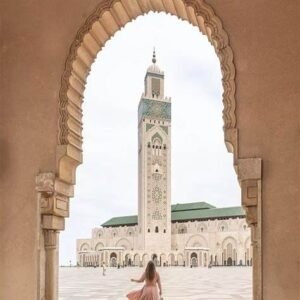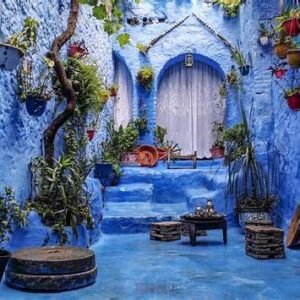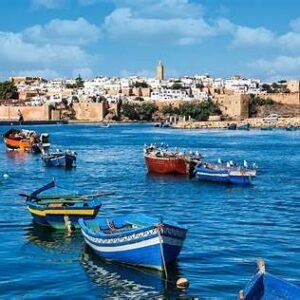


I arrived in Morocco by the Atlantic coast—the tang of salt in the air, fishermen pulling nets at dawn, a sky so wide you could believe almost anything might happen. The best places to visit in Morocco are a tapestry of contrasts: winding medinas and monumental mosques; cedar-forested mountains and sand dunes that stretch beyond sight; spice smells, mint tea, ancient traditions, and vibrant modern life. Over ten days of travel, I discovered places where Morocco’s history, landscape, and culture breathe, where you feel both small and part of something old and large.
Key Places & Their Stories
Below are some of the best places to visit in Morocco that stayed with me—beautiful, powerful, rich for travelers, and useful for anyone wanting to study Morocco’s art, ecology, architecture, or history.
1. Marrakech — Heartbeat of the Red City
The first time I entered Marrakech’s medina at dusk, I felt overwhelmed in the best way. The sky turning a bruise-purple over the red walls, the calls to prayer echoing, lanterns lighting up doorways, souks spilling over with colors, fragrances, voices.
What to see:
-
Jemaa el-Fnaa: the central square of food stalls, storytellers, snake-charmers, and performers. At dusk, it transforms.
-
Koutoubia Mosque: towering minaret, Almohad era, very visible landmark from many parts of the city.
-
Menara Gardens: historic garden with reservoir, pavilion, often framed against the High Atlas Mountains.
-
Agdal Gardens: orchards, reservoirs, palaces, historic green space, part of Marrakech’s UNESCO listing.
Why it matters / study angles:
Urban history, Almohad architecture, garden water management, and the sociology of bustling souks under modern tourism.
2. Fez (Fès) — The Living Medieval Labyrinth
Walking into Fez El Bali (Old Fez), with its narrow alleys and strong-smelling leather vats, I felt as though I was inside a living museum.
What to see:
-
Fez El Bali Medina: winding, car-free, full of craftsmen’s workshops, hidden courtyards, historic architecture.
-
University of al-Qarawiyyin: founded in 859 AD by Fatima al-Fihri, often cited as the world’s oldest continually operating university (Encyclopedia Britannica).
-
Bou Inania Madrasa: ornate tile-work, carved stucco, and historic Islamic design.
-
Chouara Tannery: iconic image of Fez with colorful dye vats.
Why it matters / study angles:
Islamic education history, crafts survival, and urban morphology in a medieval city still alive today.
3. Chefchaouen — The Blue Pearl of the Rif
Nestled in the Rif Mountains, Chefchaouen’s blue-washed alleys and doors glowed under the sun.
What to see:
-
Chefchaouen Medina: every shade of blue, from steps to doorways.
-
Kasbah views in Plaza Uta el-Hammam.
-
Hikes to waterfalls like Akchour in the Rif forest.
Why it matters / study angles:
Identity expressed in color, Rif ecology, and how small-scale tourism shapes local life.
4. Essaouira & the Atlantic Coast — Wind, Sea, Walls
Essaouira’s mellow coastal mood felt like Morocco’s oceanic breath.
What to see:
-
Essaouira Medina: Portuguese, French, and Moroccan influences in its fortifications.
-
Skala de la Kasbah ramparts overlooking the Atlantic.
-
Windsurfing, kitesurfing, and seafood markets.
Why it matters / study angles:
Coastal ecology, heritage preservation, and Essaouira’s role as a cultural melting pot.
5. High Atlas Mountains & Tizi n’Tichka Pass
Driving through Tizi n’Tichka revealed high-altitude villages, snow-capped peaks, and winding valleys.
What to see:
-
Mountain villages, agriculture, and Amazigh (Berber) culture.
-
Ourika Valley: waterfalls, traditional life, and mountain ecology.
Why it matters / study angles:
Adaptation to altitude, Amazigh traditions, and geology of mountain formation.
6. Aït Ben Haddou & Ouarzazate — Kasbahs and Cinematic Landscapes
Aït Ben Haddou, with its earthen walls and towers, is a UNESCO World Heritage site often used as a film set. Nearby Ouarzazate is known as the “gateway to the Sahara.”
Why it matters / study angles:
Vernacular earthen architecture, cinematic landscapes, and water-scarce desert edge ecology.
7. The Sahara — Erg Chebbi & Merzouga
The dunes of Erg Chebbi rose like golden waves near Merzouga. Camel treks at dawn and star-filled desert nights made this the soul of the Moroccan desert.
Why it matters / study angles:
Dune geomorphology, desert anthropology, and climate change challenges.
Practical Travel Tips for the Best Places to Visit in Morocco
-
When to go: Spring and fall for mild weather; summer is very hot inland; winter brings snow in the Atlas.
-
Cultural respect: Dress modestly, ask before photos, and haggle politely in souks.
-
Travel logistics: Riads for authentic stays, 4×4 for mountain/desert roads, French and Arabic are widely spoken.
-
Challenges: Water scarcity, erosion of kasbahs, and conservation struggles in medinas.
Final Reflections
From Fez’s medieval alleys to Erg Chebbi’s silent dunes, the best places to visit in Morocco are both history lessons and living landscapes. If you travel here, travel to learn: about architecture, deserts, traditions, and resilience. Morocco teaches in its light, its dust, its colors, and its enduring memory.
👉 Bonus: If you love Morocco, you’ll also enjoy my story from East Africa. Read about the best places to visit in Djibouti for another journey of landscapes, oceans, and desert winds.


